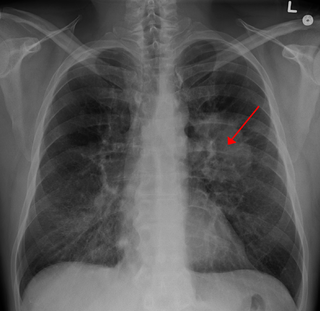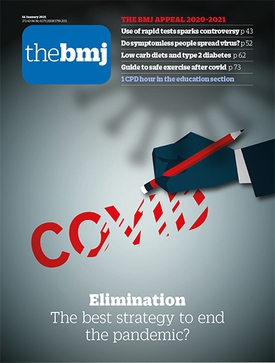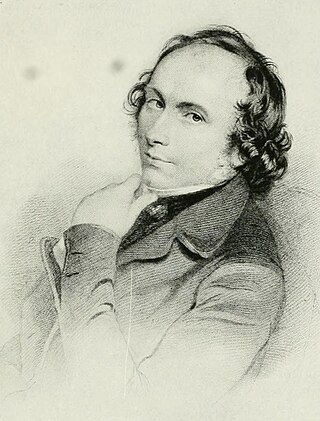
Lung cancer, also known as lung carcinoma, is a malignant tumor that begins in the lung. Lung cancers are caused by genetic damage to the DNA of cells in the airways, often exacerbated by cigarette smoking, or inhaling damaging chemicals. Damaged airway cells sometimes gain the ability to proliferate unchecked, causing the growth of a tumor. Without treatment, lung tumors can spread throughout the lung, damaging lung function. Eventually lung tumors metastasize, spreading to distant parts of the body, and causing varying disease. Lung cancers are classified based on the cells they originate from. Around 15% are small-cell lung cancers, while the remaining 85% are adenocarcinomas, squamous-cell carcinomas, and large-cell carcinomas.

A spirometer is an apparatus for measuring the volume of air inspired and expired by the lungs. A spirometer measures ventilation, the movement of air into and out of the lungs. The spirogram will identify two different types of abnormal ventilation patterns, obstructive and restrictive. There are various types of spirometers that use a number of different methods for measurement.

The BMJ is a weekly peer-reviewed medical trade journal, published by the trade union the British Medical Association (BMA). The BMJ has editorial freedom from the BMA. It is one of the world's oldest general medical journals. Originally called the British Medical Journal, the title was officially shortened to BMJ in 1988, and then changed to The BMJ in 2014. The journal is published by BMJ Publishing Group Ltd, a subsidiary of the British Medical Association (BMA). The editor-in-chief of The BMJ is Kamran Abbasi, who was appointed in January 2022.

Signs and symptoms are the observed or detectable signs, and experienced symptoms of an illness, injury, or condition. Signs are objective and externally observable; symptoms are the patient's reported subjective experiences. A sign for example may be a higher or lower temperature than normal, raised or lowered blood pressure or an abnormality showing on a medical scan. A symptom is something out of the ordinary that is experienced by an individual such as feeling feverish, a headache or other pain or pains in the body.

Spirometry is the most common of the pulmonary function tests (PFTs). It measures lung function, specifically the amount (volume) and/or speed (flow) of air that can be inhaled and exhaled. Spirometry is helpful in assessing breathing patterns that identify conditions such as asthma, pulmonary fibrosis, cystic fibrosis, and COPD. It is also helpful as part of a system of health surveillance, in which breathing patterns are measured over time.

Sir Jonathan Hutchinson, was an English surgeon, ophthalmologist, dermatologist, venereologist, and pathologist.

Polymyositis (PM) is a type of chronic inflammation of the muscles related to dermatomyositis and inclusion body myositis. Its name means "inflammation of many muscles". The inflammation of polymyositis is mainly found in the endomysial layer of skeletal muscle, whereas dermatomyositis is characterized primarily by inflammation of the perimysial layer of skeletal muscles.

Vital capacity (VC) is the maximum amount of air a person can expel from the lungs after a maximum inhalation. It is equal to the sum of inspiratory reserve volume, tidal volume, and expiratory reserve volume. It is approximately equal to Forced Vital Capacity (FVC).

William Stokes was an Irish physician, who was Regius Professor of Physic at the University of Dublin. He graduated from the University of Edinburgh Medical School with an MD in 1825 later returning the practice in Dublin at Meath Hospital. He went on to create two important works on cardiac and pulmonary diseases – A Treatise on the Diagnosis and Treatment of Diseases of the Chest (1837) and The Diseases of the Heart and Aorta (1854) – as well as one of the first treatises on the use of the stethoscope. He emphasised the importance of clinical examination in forming diagnoses, and of ward-based learning for students of medicine.
John Hutchinson may refer to:

An incentive spirometer is a handheld medical device used to help patients improve the functioning of their lungs. By training patients to take slow and deep breaths, this simplified spirometer facilitates lung expansion and strengthening. Patients inhale through a mouthpiece, which causes a piston inside the device to rise. This visual feedback helps them monitor their inspiratory effort. Incentive spirometers are commonly used after surgery or other illnesses to prevent pulmonary complications.

Cediranib is a potent inhibitor of vascular endothelial growth factor (VEGF) receptor tyrosine kinases.

Pulmonary function testing (PFT) is a complete evaluation of the respiratory system including patient history, physical examinations, and tests of pulmonary function. The primary purpose of pulmonary function testing is to identify the severity of pulmonary impairment. Pulmonary function testing has diagnostic and therapeutic roles and helps clinicians answer some general questions about patients with lung disease. PFTs are normally performed by a pulmonary function technician, respiratory therapist, respiratory physiologist, physiotherapist, pulmonologist, or general practitioner.

The Lumleian Lectures are a series of annual lectures started in 1582 by the Royal College of Physicians and currently run by the Lumleian Trust. The name commemorates John Lumley, 1st Baron Lumley, who with Richard Caldwell of the College endowed the lectures, initially confined to surgery, but now on general medicine. William Harvey did not announce his work on the circulation of the blood in the Lumleian Lecture for 1616 although he had some partial notes on the heart and blood which led to the discovery of the circulation ten years later. By that time ambitious plans for a full anatomy course based on weekly lectures had been scaled back to a lecture three times a year.

Chronic obstructive pulmonary disease (COPD) is a type of progressive lung disease characterized by long-term respiratory symptoms and airflow limitation. Systemic manifestations are known. COPD and asthma may coexist and converge in some individuals. The main symptoms of COPD include shortness of breath and a cough, which may or may not produce mucus. COPD progressively worsens, with everyday activities such as walking or dressing becoming difficult. While COPD is incurable, it is preventable and treatable.
The Hunterian Oration is a lecture of the Royal College of Surgeons of England. The oration was founded in 1813 by the executors of the will of pioneering surgeon John Hunter, his nephew Dr Matthew Baillie and his brother-in-law Sir Everard Home, who made a gift to the College to provide an annual oration and a dinner for Members of the Court of Assistants and others. In 1853, the oration and dinner became biennial; it is held on alternate years in rotation with the Bradshaw Lecture. It is delivered by a Fellow or Member of the college on 14 Feb, Hunter's birthday, "such oration to be expressive of the merits in comparative anatomy, physiology, and surgery, not only of John Hunter, but also of all persons, as should be from time to time deceased, whose labours have contributed to the improvement or extension of surgical science". The RCS Oration is not to be confused with the Hunterian Society Oration given at the Hunterian Society.
Peter John Morland Openshaw, is a British clinician and scientist specialising in lung immunology, particularly defence against viral infections. He trained in lung diseases and undertook a PhD in immunology before establishing a laboratory at St Mary's Hospital Medical School. He created the academic department of Respiratory Medicine and the Centre for Respiratory Infection at Imperial College and was elected President of the British Society for Immunology in 2014.
Kenneth William Donald (1911–1994) was a British physician, surgeon, pulmonologist, cardiologist, professor of medicine, and leading expert on underwater physiology and exercise physiology.
Race adjustment, also known as race-correction, is the calculating of a result which takes into account race. It is commonly used in medical algorithms in several specialties, including cardiology, nephrology, urology, obstetrics, endocrinology, oncology and respiratory medicine. Examples include the eGFR to assess kidney function, the STONE score for the prediction of kidney stones, the FRAX tool, to evaluate the 10-year probability of bone fracture risk, and lung function tests, to identify the severity of lung disease.
Lundy Braun is professor of pathology and laboratory medicine, and Africana studies at Brown University, United States, who researches history of racial health disparities. She wrote Breathing Race Into the Machine: The Surprising Career of the Spirometer From Plantation to Genetics (2014), which looks at the history of correcting for race in spirometers, and for which she received the Ludwik Fleck Prize in 2018.














